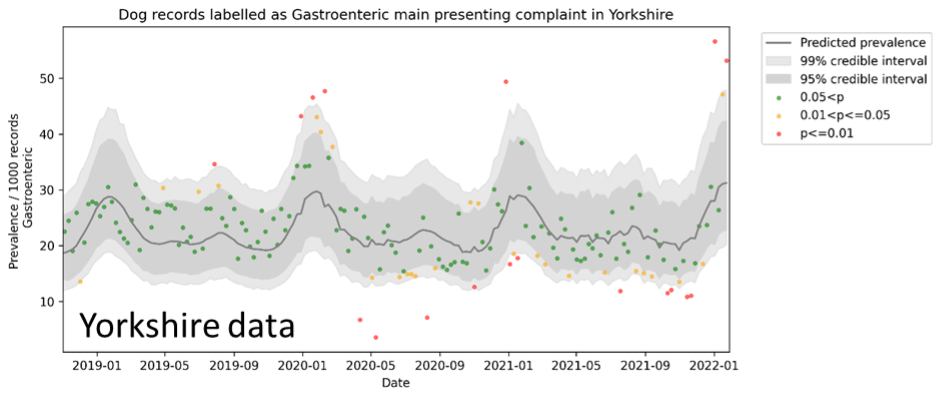UPDATED RDI: Possible outbreaks of gastrointestinal disease in dogs in the North East and Yorkshire

*FOR ALL INFORMATION INCLUDING UPDATES ON THE INCREASE IN GI DISEASE IN DOGS, CLICK HERE*
Update 25th January 2022.
This RDI replaces the one published on 14th January 2022 and includes for the first time in this investigation laboratory data as well as a regional breakdown of the data from vets in practice.
Summary
Gastrointestinal (GI) disease in dogs covers a wide range of symptoms and is generally mild. However, in a minority of cases it can be severe.
Real time data from veterinary practices collected by SAVSNET over several years suggests that such GI disease appears to be seasonal in dogs, peaking in January. In addition, there was a national outbreak of more severe GI disease affecting dogs nationally in January to May 2020 that was associated with a canine enteric coronavirus (CECoV) variant.
There are concerns from some veterinary practitioners and owners in several regions of the country starting in Yorkshire, that a similar outbreak may be occurring this January (2022).
Analysis of real-time data collected by SAVSNET from veterinary practices suggests there is some early evidence that cases of GI disease are starting to rise above the levels we might expect at this time of year.
However, such signals can change quickly; we need to collect data for another 1-2 weeks before we can decide if this change constitutes an outbreak and will continue to monitor the situation.
Data from laboratories suggests that as in previous winters, CECoV is more likely to be found in samples submitted for testing this winter. Although it is tempting to speculate on a role for CECoV, and indeed other viruses, in current cases of GI disease, that would be premature based on our current data.
If an owner is worried about their dog it is important that they contact their vet who can give advice and treatment if necessary. In addition, we would recommend affected dogs should be isolated from other dogs to minimise the risks of onward transmission.
What is the reason for the concern?
There have been recent social media reports of possible increases in acute gastrointestinal (GI) disease in the North East, characterised by vomiting and diarrhoea. To date the authors are unaware of any statistical analyses of these data or any suggestion of a possible cause.
What data have we used?
SAVSNET collects data from a sentinel network of UK veterinary practices that voluntarily contribute real time consultation data, and from a network of diagnostic veterinary laboratories. We can use these data to try and identify changes in the patterns of pet animal disease. Here we have used a unique feature of SAVSNET, and reviewed consultations that participating vets have told us are primarily for GI disease - we call this the main presenting complaint (MPC).
Results from veterinary data
The first plot below shows data up to 17th January 2022. Apart from early 2020 in dogs (more on that later), this GI MPC has a gentle seasonality at a national level in dogs (blue line), lowest in the summer and almost doubling at this time of year. Similar data for cats is less seasonal (orange line) and suggests whatever is driving this seasonality in dogs does not impact cats.
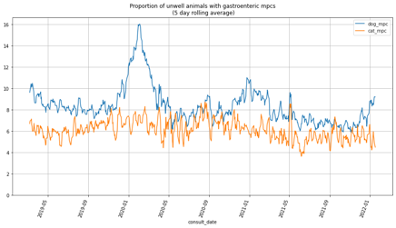
The second series of plots below are a more complex statistical analysis of the same dog data, that seeks to identify those weekly data points using red and orange dots that are significantly outwith normal ranges (shown by the grey shaded area). These plots are for different regions; at the top is the national GB data again, and in the bottom panel, data for Yorkshire.
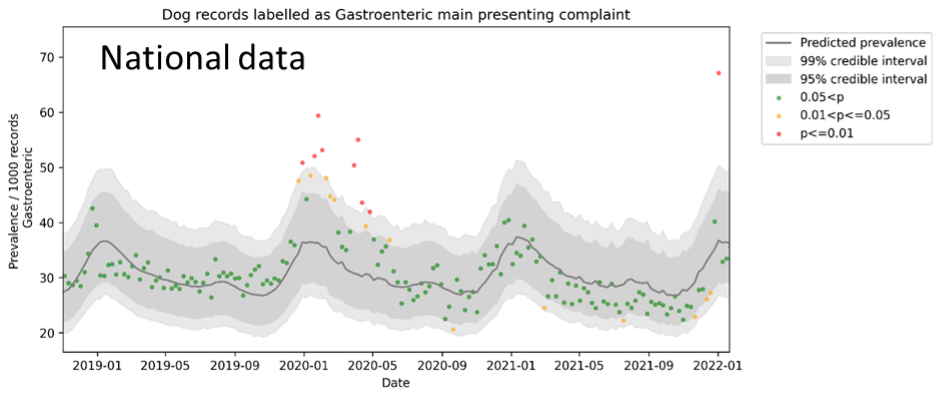
How do we interpret these observations?
1. Gastrointestinal disease in dogs is appears to be seasonal, peaking each year in January.
Together, these data suggest each winter period is associated with an increase in gastrointestinal disease in dogs. We might consider 2018-19 and 2020-21 to represent “normal” winter periods. Although not much is written about the seasonality of canine GI pathogens, it seems reasonable that as in humans, some causes may be more transmissible at certain times of the year, perhaps driven by climate or behaviour changes leading to increased chances for mixing.
2. There was a national outbreak of GI disease affecting dogs in early 2020.
In 2019-20, the winter peak was statistically much higher over a period of several weeks at the national level (eight red dots spanning roughly January – May 2020), constituting a clear outbreak which, after additional studies, we thought was likely to be caused by a variant of canine enteric coronavirus. This outbreak seemed shorter lived in Yorkshire (three red dots in the same period).
What about this winter?
This winter (2021-22), apart from a single significantly high week three weeks ago, the national pattern so far seems similar to a more normal year. The data set representing owners living in Yorkshire seems at this early stage to be more similar to the outbreak year of 2020, as shown by the two red dots on the very right of the chart. It also shows an individual significantly high week also occurred last winter.
Clearly, this represents a worrying trend and one that needs to be monitored both locally and more widely, especially as there are reports of similar increases from other regions of the country.
Currently, because of both rapid weekly fluctuations typical of such data, the short duration of these increased areas, and possible disruption to the veterinary data streams due to changed working practices during the COVID pandemic, we feel it is premature to call this an outbreak. i.e we do not believe we have strong enough evidence that what is going on is different to usual years. One or even two anomalous data points might be caused by a variety of reasons including changes in veterinary consultations that occur around Christmas and New Year.
We will continue to monitor this trend in the coming weeks to see whether future data follows the patterns typical of a more normal year, or whether it might follow a pattern more similar to that seen in January 2020. We will decide in the next two weeks whether to start collecting the additional data from both owners of affected animals and their vets necessary to shed further light on what is going on – watch this space.
What about laboratory data?
The GI outbreak of 2022 was associated with a canine enteric coronavirus variant. Using data from participating labs, we again see a seasonality to the diagnosis of CECoV that seems to broadly follow that of the GI seasonality, with the proportion of submitted samples testing positive being highest in the winter. It will be important to test samples from cases and controls to see whether this association holds.
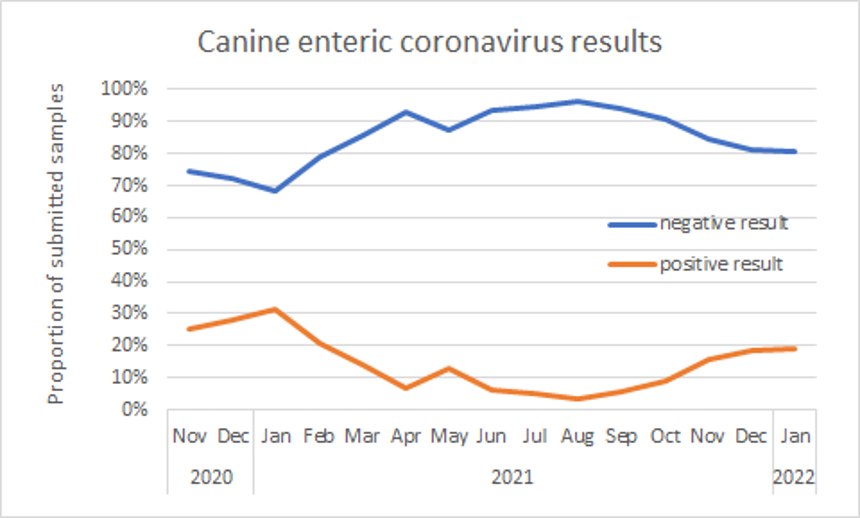
This is not the case for canine parvovirus, another pathogen that can cause severe GI signs, particularly in unvaccinated animals.
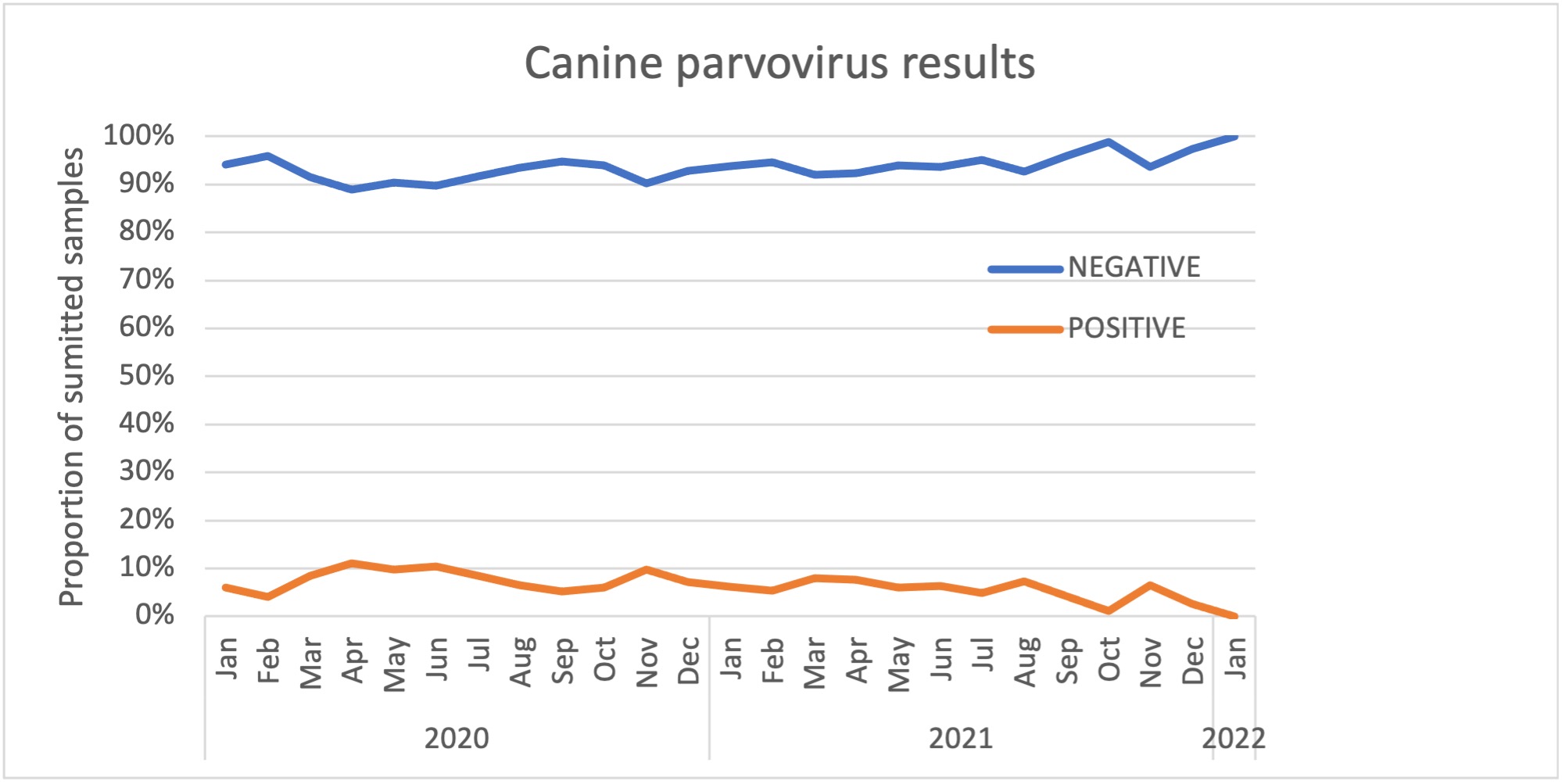
Clearly other pathogens could be involved. It will be important to test samples from cases and controls to see whether this association with CECoV holds.
Disclaimer
The data presented shows regional averages; clearly such an analysis could hide variations in this pattern specific to individual more local regions.
The MPC is broad syndrome and will likely include a range of other GI diseases for example chronic disease. SAVSNET collects data from ~10% of UK practices recruited by convenience and may therefore not necessarily be representative of the entire UK population of dogs. Data like that presented here is provided in good faith, and should not be used as proof of the presence or absence of events, anomalies or outbreaks. However, they can be used to inform discussions about possible changes of disease seen in practice.
Unfortunately we will not be able to produce RDIs for every possible scenario, and the absence of an RDI should not be used to imply there is no issue.
Advice to owners.
Even in the absence of a clear understanding of what, if anything, out of the ordinary is happening in these cases, there are important things that can be done now to lessen the impact of any possible infections on the population.
Severe acute GI disease like that being described in these cases is always unpleasant regardless of the cause, and regardless of whether it affects an individual dog or many; in severe cases, especially if left untreated, it can be life threatening. If you are an owner concerned about the health of your pet, then please contact your own veterinary surgeon who is best placed to offer advice, and treatment if necessary.
Regardless of whether the pattern of current disease is normal or not, if your dog does have vomit and / or diarrhoea, it makes sense to keep it away from other dogs (isolate) at least whilst it is ill and preferably a few days longer just in case it is infectious. And if your dog does defecate or vomit in a public place, then it is even more important to clear up after them, washing your own hands carefully afterwards. Close contact with affected dogs, and their vomit and diarrhoea are likely to be the main ways that GI bugs are transmitted.
Acknowledgments
SAVSNET is incredibly grateful to the vets (both independent and CVS group using Robovet and Teleos software) and labs (Idexx, NWL, Biobest, Battlab and VPG) who submit their data to us, and without whom such insights would not be possible.
